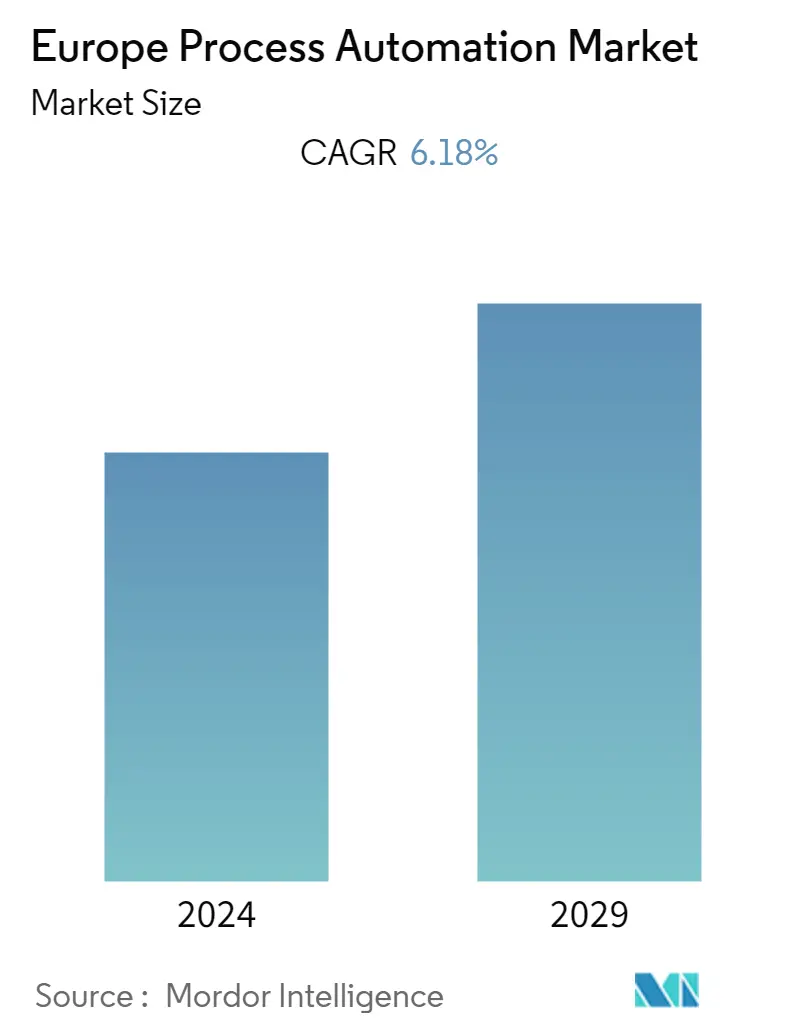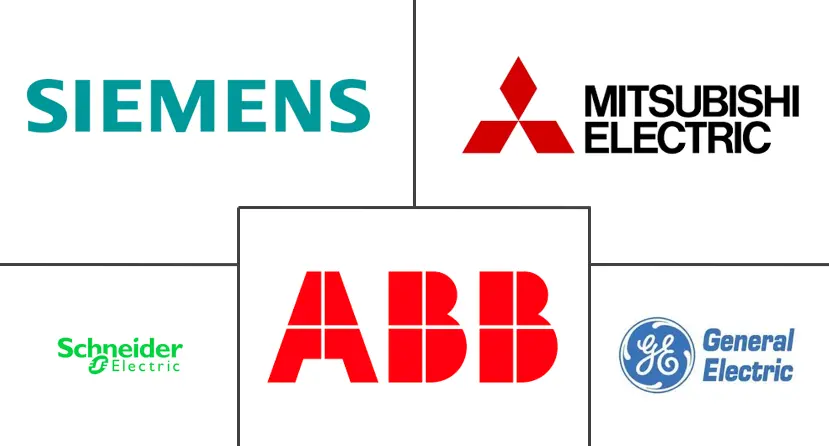Market Size of Europe Process Automation Industry

| Study Period | 2019 - 2029 |
| Base Year For Estimation | 2023 |
| Forecast Data Period | 2024 - 2029 |
| Historical Data Period | 2019 - 2022 |
| CAGR | 6.18 % |
| Market Concentration | Low |
Major Players
*Disclaimer: Major Players sorted in no particular order |
Europe Process Automation Market Analysis
The European process automation market is expected to witness a CAGR of 6.18% over the forecast period 2021 - 2026. Since COVID-19 in early 2020 had put the brakes on economic growth, it acts as a catalyst for the medium- to long-term development of industrial autonomy. The survey was conducted between June and July 2020 with over 500 decision-makers from the process industries. Moreover, 33% of respondents highlighted a slight increase in investment toward autonomous operations in 3 years as a direct impact by COVID-19.
- The IoT demand trend is expected to shift toward industrial space from consumer demand over the near future, primarily driven by various Industry 4.0 applications. Countries like the United Kingdom are on the verge of the industrial revolution, as data is being used on a large scale for production while integrating it with various manufacturing systems throughout the supply chain.
- European nations have been at the forefront of adopting industrial automation solutions and have been under the government's constant support. For instance, the UK government revealed the Industrial Strategy primarily outlined a plan to invest GBP 2 billion per year by 2020 for new research and development in the technology sector. Smart manufacturing and the Industrial Internet of Things (IIot) will be built upon the work that automation has already forged over these years. Focusing on the possibilities that the automation solutions will enable will present the opportunity for multiple industries to push the boundaries of technological innovation, which is crucial for the UK economy in a post-Brexit phase. Automation solutions are expected to revolutionize the process industries.
- Furthermore, process industries, such as chemical and petrochemical, paper and pulp, water and wastewater treatment, energy and utilities, oil and gas, pharmaceutical, food, and beverages, are expected to fuel growth.
- Industrial system architects, integrators, and machine builders have leveraged connected computing advances to aid manufacturing facilities function more efficiently. The rising need for real-time intelligence, better control of operations, scheduling, and increasing market penetration of big data analytics in the manufacturing industry is expected to generate demand for advanced process automation in the near future. Big data analytics has been used to refine complicated processes and manage supply chains.
- Moreover, big data analytics allows an enterprise to use factory automation to shift from reactionary practices to predictive ones. This change targets to improve the efficiency of the process and performance of the product.
Europe Process Automation Industry Segmentation
The study characterizes the process automation market based on the system type, end-user industry, and country. The study describes the process automation market based on the technology type, a communication protocol that includes wired and wireless protocol, System type, end-user industry, and country. Further, the study comprises Software & Services and the impact of COVID-19 on the market.
| By Communication Protocol | |
| Wired | |
| Wireless |
| By System Type | |||||||||||
| |||||||||||
|
| By End-user Industry | |
| Oil and Gas | |
| Chemical and Petrochemical | |
| Power and Utilities | |
| Water & Wastewater | |
| Food and Beverage | |
| Paper & Pulp | |
| Pharmaceutical | |
| Other End-user Industries |
| By Country | |
| United Kingdom | |
| Germany | |
| France | |
| Rest of Europe |
Europe Process Automation Market Size Summary
The European process automation market is poised for significant growth, driven by the increasing adoption of industrial automation solutions across various sectors. The COVID-19 pandemic has accelerated the shift towards industrial autonomy, with companies investing more in autonomous operations. The demand for IoT is shifting from consumer to industrial applications, fueled by Industry 4.0 initiatives. European countries, particularly the United Kingdom, are leveraging data integration and smart manufacturing to enhance production efficiency. Government support, such as the UK's Industrial Strategy, underscores the commitment to advancing technology sectors, which is crucial for economic resilience post-Brexit. The market is expected to benefit from advancements in big data analytics, enabling predictive automation and improved operational efficiency across industries like chemicals, pharmaceuticals, and food and beverages.
The process automation market in Europe is characterized by moderate fragmentation, with a mix of established players and new entrants driving innovation and strategic partnerships. Key industries such as pharmaceuticals and food and beverages are increasingly adopting automation to enhance productivity, reduce errors, and improve cost efficiency. The pandemic has further highlighted the importance of automation in maintaining operational continuity. Technologies like Robotic Process Automation (RPA) and advanced industrial control systems are becoming integral to business process management. Recent developments, such as Schneider Electric's merger with Larsen & Toubro's Electrical & Automation business and Siemens' launch of a new servo motor, reflect the ongoing evolution and investment in the market. These advancements are expected to bolster the market's growth trajectory, offering opportunities for enhanced operational capabilities and competitive advantage.
Europe Process Automation Market Size - Table of Contents
-
1. MARKET DYNAMICS
-
1.1 Market Overview
-
1.2 Industry Attractiveness - Porter's Five Forces Analysis
-
1.2.1 Bargaining Power of Suppliers
-
1.2.2 Bargaining Power of Buyers
-
1.2.3 Threat of New Entrants
-
1.2.4 Threat of Substitutes
-
1.2.5 Intensity of Competitive Rivalry
-
-
1.3 Industry Value Chain Analysis
-
1.4 Market Drivers (Growing emphasis on energy efficiency & cost reduction| Demand for Safety Automation Systems| Emergence of IIoT)
-
1.5 Market Challenges (Cost & Implementation Challenges)
-
1.6 Industry Standards & Regulations
-
1.7 Analysis of the major Industrial Automation hubs in the United Kingdom, Germany, and France - To be identified based on the investor activity & expansion activities undertaken over the last 3 years
-
-
2. MARKET SEGMENTATION
-
2.1 By Communication Protocol
-
2.1.1 Wired
-
2.1.2 Wireless
-
-
2.2 By System Type
-
2.2.1 By System Hardware
-
2.2.1.1 Supervisory Control and Data Acquisition System (SCADA)
-
2.2.1.2 Distributed Control System (DCS)
-
2.2.1.3 Programmable Logic Controller (PLC)
-
2.2.1.4 Manufacturing Execution System (MES)
-
2.2.1.5 Valves & Actuators
-
2.2.1.6 Electric Motors
-
2.2.1.7 Human Machine Interface (HMI)
-
2.2.1.8 Process Safety Systems
-
2.2.1.9 Sensors & Transmitters
-
-
2.2.2 By Software Type
-
2.2.2.1 APC (Standalone & Customized Solutions)
-
2.2.2.1.1 Advanced Regulatory Control
-
2.2.2.1.2 Multivariable Model
-
2.2.2.1.3 Inferential & Sequential
-
-
2.2.2.2 Data Analytics & Reporting-based Software
-
2.2.2.3 Other Software & Services
-
-
-
2.3 By End-user Industry
-
2.3.1 Oil and Gas
-
2.3.2 Chemical and Petrochemical
-
2.3.3 Power and Utilities
-
2.3.4 Water & Wastewater
-
2.3.5 Food and Beverage
-
2.3.6 Paper & Pulp
-
2.3.7 Pharmaceutical
-
2.3.8 Other End-user Industries
-
-
2.4 By Country
-
2.4.1 United Kingdom
-
2.4.2 Germany
-
2.4.3 France
-
2.4.4 Rest of Europe
-
-
Europe Process Automation Market Size FAQs
What is the current Europe Process Automation Market size?
The Europe Process Automation Market is projected to register a CAGR of 6.18% during the forecast period (2024-2029)
Who are the key players in Europe Process Automation Market?
ABB Limited, Siemens AG, Schneider Electric SE, General Electric Co. and Mitsubishi Electric Corporation are the major companies operating in the Europe Process Automation Market.

